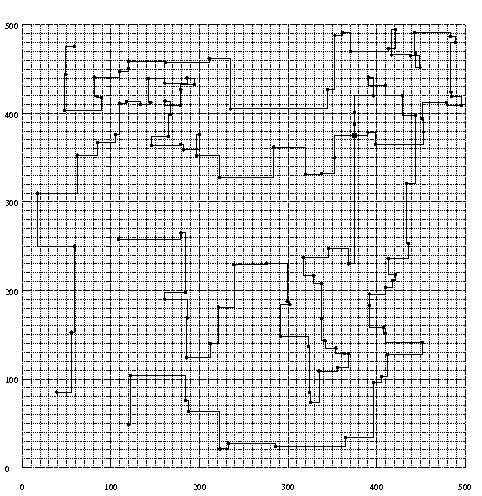


 |

|
 |
Dutch version/Nederlandse versie ![]()
Welcome to WHIZZKIDS '96
On this website you will find information about the Whizzkids '96 Contest. This mathematics challenge has been sponsored by CMG (consultants in information technology) and was published by De Telegraaf (a Dutch newspaper). The problem to be solved has been designed by Jan Karel Lenstra (EUT/CWI), Emile Aarts (EUT/Philips Research) and co-workers.
Competition was open for everybody, and there was a special category for professionals (i.e., those who are involved in mathematics and computing science research and teaching).
A complete Dutch description was available, at the time of publication of the
puzzle, at CMG. The problem is to cluster and
route a news paper delivery plan. Four news paper delivery boys deliver 120
newspapers to the subscribers. They start at the same time from a single
depot. The problem is to deliver the LAST newspaper AS EARLY AS POSSIBLE. To
avoid numerical difficulties the problem has been situated in Manhattan.
Therefore we can describe the subscribers' addresses by simple
(x,y)-coordinates, and the distance between any pair of subscribers is defined
by the Manhattan-distance. A numerical table is obtained from the numerical data file.
We received over 900 submissions. In some of these some mistakes
were made, in particular in computing the distances. However most people had no problem in
describing a feasible solution. A 14 year old high school student using a paper-and-pencil
approach even beat the professional participants!!!
The best solution was found by a group of Eindhoven students in Computing Science.
The last news paper is delivered at 1183 time units from the start. There were more
solutions with this value, but the Eindhoven students had also the smallest average
delivery time.
Find hereunder their story of
sleepless nights. A solution similar to the one found by the
students is given in the following figure.

with the four routes given by:
Note that this is not necessarily the optimum solution. We can prove a lower bound of 1160, so a gap remains of 2 percent. The professionals did not do too well in 1996. Of course students can spend much more time and computing power on these real-life instances of combinatorial problems...
It is also possible to use a computer as a tool for supporting a solution approach based on human insight. Diego Lont (also an Eindhoven Computing Science student) together with his colleagues designed a tool that displays the routes on a screen, and allows the user to modify the routes by moving addresses between the routes. Solution characteristics are automatically updated. It is found in route editor file.
We hope that everyone has enjoyed this puzzle. There is still one open question, with a reward: The first one to produce a solution with a maxiaml routelength STRICTLY LESS than 1183, OR with a MATHEMATHICALLY SOUND PROOF that no such solution exists, can win another 5000 GUILDERS from CMG.
Update: it has been shown by Bill Cook et al that the best solution submitted is the true optimum solution, both for a min-max of 1183, as well as the minimum average delivery time 558.81667. A full description is found in David Applegate, William Cook, Sanjeeb Dash, André Rohe, (2002) Solution of a Min-Max Vehicle Routing Problem. INFORMS Journal on Computing 14(2):132-143. Online version.
![]()
![]()
This page was modified last on: December 23, 1997, by Cor Hurkens (wscor@win.tue.nl)